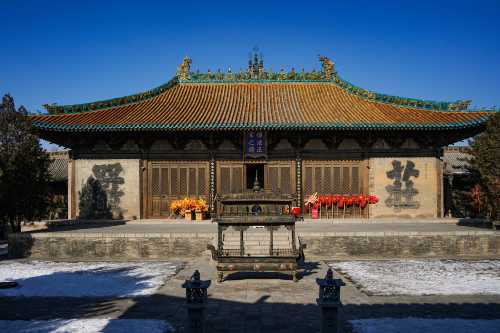Popular Trip Moments
XuanKong Temple | ✨ Shanxi’s Timeless Wonders: From Hanging Temples to Lantern Nights 🏮⛰️ | Shanxi's Unique Attractions: Hanging Temple of Mount Heng and Yingxian Wooden Pagoda | Stay at Hunyuan State Office Inn and embark on a cultural journey through the ancient city! | The Flames on the Majestic Peaks—The Splendor of Mount Heng's Sunrise | The majestic atmosphere of the vast northern peak - Hunyuan Hengshan | A Glimpse of a Thousand Years, Shanxi Right Before Your Eyes: 6-Day Itinerary Covering Taiyuan, Hongtong, Datong, and More | Stay at the Hunyuan State Office Inn | ULTIMATE CHINA 15 DAYS TRIP : PANDAS, ADRENALINE AND KARAOKE BARS | National Day 7-Day Pure Tour in Shanxi / Datong + Xiaoxitian + Pingyao | Off-Season Travel Perfection: Visit Shanxi in September and Win Big! | Beijing → Datong 5 Days 4 Nights Self-Driving Tour | 2 Days 1 Night Exploring Datong Ancient City | Take You Through a Millennium | Shanxi Ancient Architecture 9-Day Pilgrimage Itinerary | Found a treasure! These 5 hidden ways to play in Datong, locals keep them secret from tourists… | A hidden gem city Shuo Zhou: check in two national treasure-level buildings and two low-key ancient temples in one day | 7-Day Taiyuan Itinerary | Explore the Hunyuan State Office and Unlock a Unique Blend of Ancient Charm and Modern Experience | Hanging Temple of Hengshan | Immersive Ancient Charm Journey with Exclusive Privileges | Escape Plan for the Working Class: A Soul-Stirring Buddhist Art Sanctuary! | Shanxi Ancient Architecture Tour | Datong Four Days and Three Nights Guide! (Super Relaxed Version) | Revisiting Datong, the Same Scenery but Different Emotions | Shanxi Anyang Taihang Journey | Hanging Temple (悬空寺): A Gravity-Defying Wonder | Hanging Monastery (Xuankong Si, Shanxi) | Hanging Temple of Datong Travel Guide | A Millennium-Old Temple Suspended on Cliffs | Hanging Out at Huayan and Hanging Temple | 7-Day In-Depth Travel Guide to Shanxi Hanging Temple: A Journey Blending History, Nature, and Culture
Recommended Attractions at Popular Destinations
Popular Attractions in Singapore | Popular Attractions in Bali | Popular Attractions in Beijing | Popular Attractions in Tokyo | Popular Attractions in Kyoto | Popular Attractions in Barcelona | Popular Attractions in Dubai | Popular Attractions in Rome | Popular Attractions in Shanghai | Popular Attractions in Sydney | Popular Attractions in Osaka | Popular Attractions in Zanzibar Island | Popular Attractions in Phuket | Popular Attractions in Chefchaouene | Popular Attractions in Paris | Popular Attractions in Melbourne | Popular Attractions in London | Popular Attractions in Kuala Lumpur | Popular Attractions in Los Angeles | Popular Attractions in Las Vegas | Popular Attractions in Iguazu National Park(Argentina) | Popular Attractions in New York | Popular Attractions in Walt Disney World Resort | Popular Attractions in West Lake | Popular Attractions in Bangkok | Popular Attractions in Chengdu | Popular Attractions in Madrid | Popular Attractions in Jungfrau Region | Popular Attractions in Milan | Popular Attractions in Florence
Popular Attractions
Jingshi Valley | Daguan Peak | Shuangfeng Chayun Scenic Resort | Heilong Pool | Fanziya | Taohuayu | Qiantang River | Houshi Dock | Gushan Park | Pavilion of High Mountain and Flowing Water | Red Gate Palace | House of the Xue Family | Cuihua Mountain·Qinling Zhongnanshan Unesco Global Geopark | Wolong Bridge | Wangxian Bridge | Riyue Bay | Nanyan Bay | Poh San Teng Temple | Melaka Butterfly & Reptile Sanctuary (Taman Rama-rama & Reptilia Melaka) | Former Residence of Su Zhaozheng | Augustinian Order - Ballyboden- Parish Office | Vishwakarma Mandir | ping shan si | Masjid Nurul Huda Panggung | Công Viên 25/10 | Erlebnisgarten | Bhagwati Temple Riyara | King Cobra Show | Padel figueruelas | Tsukanokoshidai Park
Popular Restaurants in Hunyuan
北岳恒山村 | Caijia Restaurant (yong'andajie) | Jinbeilaochu | XIAO XI FU LIANG FEN XI GUAN DIAN XI GUAN DIAN | 蔡家酒楼(一德街店) | 翻滚吧蛋糕君 | 龙盛铜火锅 | Hunyuanliangfen | 荣盛源家宴 | 大喜凉粉宴 | 顺裕居粗粮馆 | 幸福里羊汤 | 京同生日蛋糕二部 | 恒岳国际酒店·中餐厅 | 张三凉粉 | 鸿福酒楼(恒山南路山门店) | 大山粗粮馆 | 王婆大虾(浑源县店) | 黄六饭店 | 莜面烧麦馆 | Dicos (hunyuanyong'an) | 缘子生日蛋糕工作室(鑫源小学店) | 好好吃蛋糕店(东关小学店) | Bujianbusanxiuxianba | 后院味道四季粗粮 | 张三凉粉店(永安东街店) | 锦峰食府 | 乐客黄焖鸡米饭(浑源店) | Caiyunxuandangaofang | 恒吉利大酒店-中餐厅
Popular Ranked Lists
Popular Trending Attractions in Huangshan | Top 10 Trending Attractions in Hangzhou | Popular Trending Attractions in Kaifeng | Popular Luxury Hotels in Ningbo | Top 20 Premium Hotels in Lishui | Top 50 Must-Visit Restaurants in Xi'an | Top 50 Must-Visit Restaurants in George Town | Popular Premium Hotels in Jining | Top 10 Premium Hotels in Datong | Top 50 Must-Visit Restaurants in Koh Samui | Top 50 Must-Visit Restaurants in Chengdu | Top 50 Must-Visit Restaurants in Kuala Lumpur | Top 10 Trending Attractions in Yangzhou | Top 50 Must-Visit Restaurants in Rome | Top 10 Luxury Hotels in Chongqing | Top 10 Premium Hotels in Tangshan | Popular Premium Hotels in Yongjia | Top 50 Must-Visit Restaurants in Hanoi | Top 50 Must-Visit Restaurants in Songyang | Top 20 Premium Hotels in Nantong | Popular Trending Attractions in Osaka | Popular Trending Attractions in Changchun | Popular Premium Hotels in Changzhi | Popular Trending Attractions in Changzhou | Top 50 Must-Visit Restaurants in Athens | Popular Premium Hotels in Yuxi | Top 50 Must-Visit Restaurants in Dubai | Popular Trending Attractions in Paris | Popular Trending Attractions in Yinchuan | Top 10 Trending Attractions in Tianjin
About
Payment methods
Our partners
Copyright © 2025 Trip.com Travel Singapore Pte. Ltd. All rights reserved
Site Operator: Trip.com Travel Singapore Pte. Ltd.
Site Operator: Trip.com Travel Singapore Pte. Ltd.

























